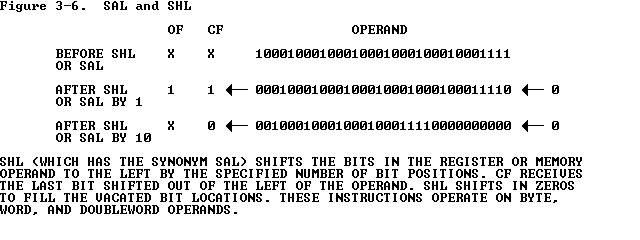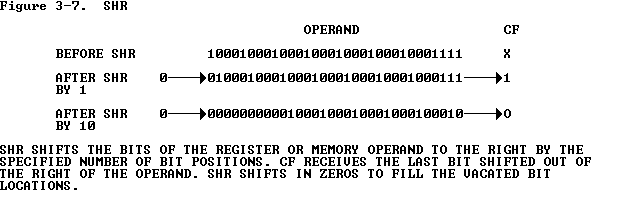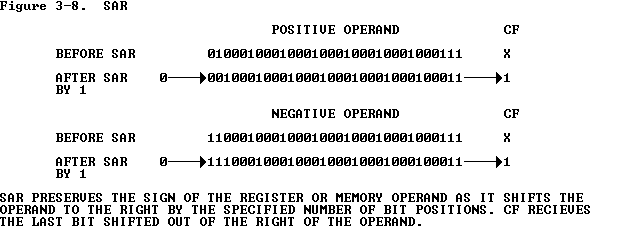
Bits are shifted from the register operand into the memory or register
operand. CF is set to the value of the last bit shifted out of the
destination operand. SF, ZF, and PF are set according to the value of the
result. OF and AF are left undefined.
SHLD (Shift Left Double)
shifts bits of the R/M field to the left, while
shifting high-order bits from the Reg field into the R/M field on the right
(see
Figure 3-10).
The result is stored back into the R/M operand. The Reg
field is not modified.
SHRD (Shift Right Double)
shifts bits of the R/M field to the right, while
shifting low-order bits from the Reg field into the R/M field on the left
(see
Figure 3-11).
The result is stored back into the R/M operand. The Reg
field is not modified.
Rotates affect only the carry and overflow flags. CF may act as an
extension of the operand in two of the rotate instructions, allowing a bit
to be isolated and then tested by a conditional jump instruction (JC or
JNC).
CF always contains the value of the last bit rotated out, even if the
instruction does not use this bit as an extension of the rotated operand.
In single-bit rotates, OF is set if the operation changes the high-order
(sign) bit of the destination operand. If the sign bit retains its original
value, OF is cleared. On multibit rotates, the value of OF is always
undefined.
ROL (Rotate Left)
rotates the byte, word, or doubleword destination operand
left by one or by the number of bits specified in the count operand (an
immediate value or the value contained in CL). For each rotation specified,
the high-order bit that exits from the left of the operand returns at the
right to become the new low-order bit of the operand. See
Figure 3-12.
ROR (Rotate Right)
rotates the byte, word, or doubleword destination
operand right by one or by the number of bits specified in the count operand
(an immediate value or the value contained in CL). For each rotation
specified, the low-order bit that exits from the right of the operand
returns at the left to become the new high-order bit of the operand.
See
Figure 3-13.
RCL (Rotate Through Carry Left)
rotates bits in the byte, word, or
doubleword destination operand left by one or by the number of bits
specified in the count operand (an immediate value or the value contained in
CL).
This instruction differs from
ROL in that it treats CF as a high-order
one-bit extension of the destination operand. Each high-order bit that exits
from the left side of the operand moves to CF before it returns to the
operand as the low-order bit on the next rotation cycle. See
Figure 3-14
.
RCR (Rotate Through Carry Right)
rotates bits in the byte, word, or
doubleword destination operand right by one or by the number of bits
specified in the count operand (an immediate value or the value contained in
CL).
This instruction differs from ROR in that it treats CF as a low-order
one-bit extension of the destination operand. Each low-order bit that exits
from the right side of the operand moves to CF before it returns to the
operand as the high-order bit on the next rotation cycle. See
Figure 3-15
.
SETcc (Set Byte on Condition cc)
set a byte to one if condition cc is true;
sets the byte to zero otherwise. Refer to Appendix D for a definition of
the possible conditions.
The difference between
TEST and
AND is that TEST
does not alter the destination operand.
TEST differs from BT in that
TEST is useful for testing
the value of multiple bits in one operations, whereas
BT tests a single bit.
up:
Chapter 3 -- Applications Instruction Set


3.4.4.2 Double-Shift Instructions
These instructions provide the basic operations needed to implement
operations on long unaligned bit strings. The double shifts operate either
on word or doubleword operands, as follows:
Of the two input operands, one may either be in a general register or in
memory, while the other may only be in a general register. The results
replace the memory or register operand. The number of bits to be shifted is
specified either in the CL register or in an immediate byte of the
instruction.
3.4.4.3 Rotate Instructions
Rotate instructions allow bits in bytes, words, and doublewords to be
rotated. Bits rotated out of an operand are not lost as in a shift, but are
"circled" back into the other "end" of the operand.






3.4.4.4 Fast "BIT BLT" Using Double Shift Instructions
One purpose of the double shifts is to implement a bit string move, with
arbitrary misalignment of the bit strings. This is called a "bit blt" (BIT
BLock Transfer.) A simple example is to move a bit string from an arbitrary
offset into a doubleword-aligned byte string. A left-to-right string is
moved 32 bits at a time if a double shift is used inside the move loop.
MOV ESI,ScrAddr
MOV EDI,DestAddr
MOV EBX,WordCnt
MOV CL,RelOffset ; relative offset Dest-Src
MOV EDX,[ESI] ; load first word of source
ADD ESI,4 ; bump source address
BltLoop:
LODS ; new low order part
SHLD EDX,EAX,CL ; EDX overwritten with aligned stuff
XCHG EDX,EAS ; Swap high/low order parts
STOS ; Write out next aligned chunk
DEC EBX
JA BltLoop
This loop is simple yet allows the data to be moved in 32-bit pieces for
the highest possible performance. Without a double shift, the best that can
be achieved is 16 bits per loop iteration by using a 32-bit shift and
replacing the
XCHG with a
ROR by 16 to swap high and low order parts of
registers. A more general loop than shown above would require some extra
masking on the first doubleword moved (before the main loop), and on the
last doubleword moved (after the main loop), but would have the same basic
32-bits per loop iteration as the code above.
3.4.4.5 Fast Bit-String Insert and Extract
The double shift instructions also enable:
The following coded examples illustrate bit insertion and extraction under
variousconditions:
; Insert a right-justified bit string from register into
; memory bit string.
;
; Assumptions:
; 1) The base of the string array is dword aligned, and
; 2) the length of the bit string is an immediate value
; but the bit offset is held in a register.
;
; Register ESI holds the right-justified bit string
; to be inserted.
; Register EDI holds the bit offset of the start of the
; substring.
; Registers EAX and ECX are also used by this
; "insert" operation.
;
MOV ECX,EDI ; preserve original offset for later use
SHR EDI,3 ; signed divide offset by 8 (byte address)
AND CL,7H ; isolate low three bits of offset in CL
MOV EAX,[EDI]strg_base ; move string dword into EAX
ROR EAX,CL ; right justify old bit field
SHRD EAX,ESI,length ; bring in new bits
ROL EAX,length ; right justify new bit field
ROL EAX,CL ; bring to final position
MOV [EDI]strg_base,EAX ; replace dword in memory
; Insert a right-justified bit string from register into
; memory bit string.
;
; Assumptions:
; 1) The base of the string array is dword aligned, and
; 2) the length of the bit string is an immediate value
; but the bit offset is held in a register.
;
; Register ESI holds the right-justified bit string
; to be inserted.
; Register EDI holds the bit offset of the start of the
; substring.
; Registers EAX, EBX, ECX, and EDI are also used by
; this "insert" operation.
;
MOV ECX,EDI ; temp storage for offset
SHR EDI,5 ; signed divide offset by 32 (dword address)
SHL EDI,2 ; multiply by 4 (in byte address format)
AND CL,1FH ; isolate low five bits of offset in CL
MOV EAX,[EDI]strg_base ; move low string dword into EAX
MOV EDX,[EDI]strg_base+4 ; other string dword into EDX
MOV EBX,EAX ; temp storage for part of string + rotate
SHRD EAX,EDX,CL ; double shift by offset within dword + EDX:EAX
SHRD EAX,EBX,CL ; double shift by offset within dword + right
SHRD EAX,ESI,length ; bring in new bits
ROL EAX,length ; right justify new bit field
MOV EBX,EAX ; temp storage for part of string + rotate
SHLD EAX,EDX,CL ; double shift back by offset within word + EDX:EAX
SHLD EDX,EBX,CL ; double shift back by offset within word + left
MOV [EDI]strg_base,EAX ; replace dword in memory
MOV [EDI]strg_base+4,EDX ; replace dword in memory
; Insert right-justified bit string from register into
; memory bit string.
;
; Assumptions:
; 1) The base of the string array is dword aligned, and
; 2) the length of the bit string is 32
; but the bit offset is held in a register.
;
; Register ESI holds the 32-bit string to be inserted.
; Register EDI holds the bit offset of the start of the
; substring.
; Registers EAX, EBX, ECX, and EDI are also used by
; this "insert" operation.
;
MOV EDX,EDI ; preserve original offset for later use
SHR EDI,5 ; signed divide offset by 32 (dword address)
SHL EDI,2 ; multiply by 4 (in byte address format)
AND CL,1FH ; isolate low five bits of offset in CL
MOV EAX,[EDI]strg_base ; move low string dword into EAX
MOV EDX,[EDI]strg_base+4 ; other string dword into EDX
MOV EBX,EAX ; temp storage for part of string + rotate
SHRD EAX,EDX ; double shift by offset within dword + EDX:EAX
SHRD EDX,EBX ; double shift by offset within dword + right
MOV EAX,ESI ; move 32-bit bit field into position
MOV EBX,EAX ; temp storage for part of string + rotate
SHLD EAX,EDX ; double shift back by offset within word + EDX:EAX
SHLD EDX,EBX ; double shift back by offset within word + left
MOV [EDI]strg_base,EAX ; replace dword in memory
MOV [EDI]strg_base,+4,EDX ; replace dword in memory
; Extract a right-justified bit string from memory bit
; string into register
;
; Assumptions:
; 1) The base of the string array is dword aligned, and
; 2) the length of the bit string is an immediate value
; but the bit offset is held in a register.
;
; Register EAX holds the right-justified, zero-padded
; bit string that was extracted.
; Register EDI holds the bit offset of the start of the
; substring.
; Registers EDI, and ECX are also used by this "extract."
;
MOV ECX,EDI ; temp storage for offset
SHR EDI,3 ; signed divide offset by 8 (byte address)
AND CL,7H ; isolate low three bits of offset
MOV EAX,[EDI]strg_base ; move string dword into EAX
SHR EAX,CL ; shift by offset within dword
AND EAX,mask ; extracted bit field in EAX
; Extract a right-justified bit string from memory bit
; string into register.
;
; Assumptions:
; 1) The base of the string array is dword aligned, and
; 2) the length of the bit string is an immediate
; value but the bit offset is held in a register.
;
; Register EAX holds the right-justified, zero-padded
; bit string that was extracted.
; Register EDI holds the bit offset of the start of the
; substring.
; Registers EAX, EBX, and ECX are also used by this "extract."
MOV ECX,EDI ; temp storage for offset
SHR EDI,5 ; signed divide offset by 32 (dword address)
SHL EDI,2 ; multiply by 4 (in byte address format)
AND CL,1FH ; isolate low five bits of offset in CL
MOV EAX,[EDI]strg_base ; move low string dword into EAX
MOV EDX,[EDI]strg_base+4 ; other string dword into EDX
SHRD EAX,EDX,CL ; double shift right by offset within dword
AND EAX,mask ; extracted bit field in EAX
3.4.5 Byte-Set-On-Condition Instructions
This group of instructions sets a byte to zero or one depending on any of
the 16 conditions defined by the status flags. The byte may be in memory or
may be a one-byte general register. These instructions are especially useful
for implementing Boolean expressions in high-level languages such as Pascal.
3.4.6 Test Instruction
TEST (Test)
performs the logical "and" of the two operands, clears OF and
CF, leaves AF undefined, and updates SF, ZF, and PF. The flags can be tested
by conditional control transfer instructions or by the byte-set-on-condition
instructions. The operands may be doublewords, words, or bytes.
prev: 3.3 Decimal Arithmetic Instructions
next: 3.5 Control Transfer Instructions